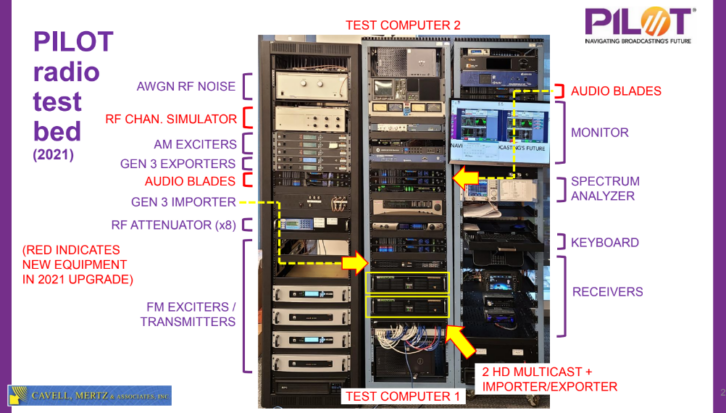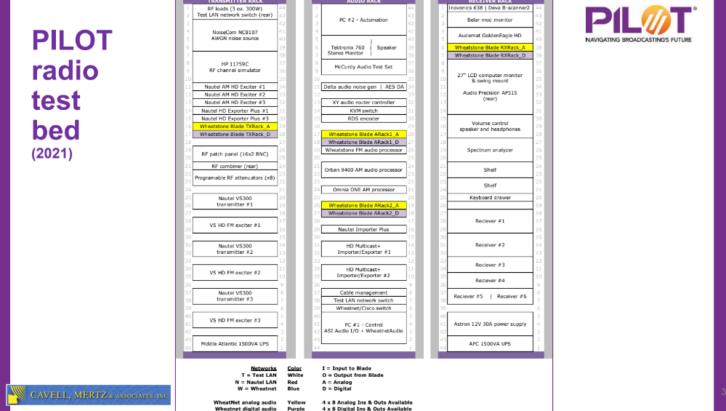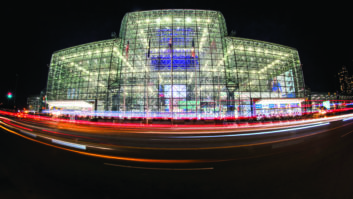A seldom-discussed aspect of standards development and equipment testing for AM and FM radio is who does the testing and what kind of gear they use.
The National Association of Broadcasters today is in a position to do this type of work as part of its PILOT technology initiative. It has a custom-built radio “test bed” to make those evaluations and gather data. The test bed, which now resides at NAB headquarters in Washington, occupies three racks and is available as a resource for industry projects.

David Layer, vice president, advanced engineering at the NAB, said the test bed has evolved over time to keep up with industry demands.
“It was originally created for the NAB with AM-only capability in 2014. Design and construction were done by Cavell, Mertz & Associates, with Dan Ryson (now with CBS) and Cavell Mertz senior engineer Mike Rhodes as the principal engineers.”
At that time, the main impetus was all-digital AM HD Radio co-channel interference testing. Layer said the FCC’s technical record on all-digital AM was sparse, so it was up to the industry to supply the necessary data to the commission and push for authorization.

“Under NAB’s leadership, all-digital AM was field-tested at nine stations in the United States, where the emphasis was on coverage. Subsequently, it was lab-tested using the PILOT radio test bed, where the emphasis was on co-channel interference. These efforts contributed greatly to the FCC authorizing digital AM in 2020.
“After the AM work was completed,” Layer continued, “NAB partnered with Cavell Mertz, Nautel and Xperi for HD Radio FM-band MP11 mode testing in 2017. For that, FM capability and a third rack were added to the test bed. FM transmitters and receivers were installed. Nautel built special test equipment for MP11 transmission. The result of this research was Xperi’s rollout of MP11 software, as well as Hubbard Broadcasting and others moving forward with MP11 adoption at their facilities.”

In 2021 the test bed moved from the Cavell Mertz offices in northern Virginia to the new NAB headquarters in southeast Washington. It was also time for another upgrade.
“The original audio distribution system was based on conventional patch panels and had become obsolete by this time. It was replaced with audio blades from Wheatstone,” said Layer. Two test computers, an RF channel simulator and two fourth-generation Nautel HD Multicast+ units were added, as well.
Last year the test bed was further upgraded to add text and image metadata transmission and reception capabilities. RCS contributed a license for their Zetta playout system, while Xperi contributed a license for its RAPID cloud-based metadata management system.

While the test bed may appear a bit intimidating in photos, the concept is fairly simple and more easily understood with flow diagrams.
The transmitter rack RF path contains three Nautel FM transmitters with associated RF attenuators and patch bays, as well as three Nautel AM exciters, also connected to the patch bay. There is also an HP 11759C RF channel simulator which is currently being integrated into the test bed.
Transmitters and exciters can be configured so that one is generating the desired signal, while the other two can create undesired signals, to serve as co- or adjacent-channel interference. A NoiseCom NC8107A is also available as an RF noise source.
A Mini Circuits ZFSC-6-1 combiner connects to all the sources, and the output goes to a digitally controllable variable attenuator.

The RF path in the receiver rack begins with a Mini Circuits ZFSC-16-12+ which takes the transmitter rack output and routes it to a number of receivers and measurement devices. This includes up to eight receivers, a spectrum analyzer, Audemat AM/FM mod monitor, Belar FM modulation monitor, Inovonics 638 FM/HD/RCS receiver, Deva Band Scanner, and Audio Precision APx515 audio analyzer.
The audio rack contains analog and digital audio blades, which can route the outputs of all the receivers, RF monitors, audio processors and APx515 analyzer to the inputs of headphones and speakers, and other audio monitors.
Audio processors include a Wheatstone FM, Omnia One AM and Orban 9400 AM. Importers include a Nautel Importer Plus and a pair of HD Multicast+ importer/exporters. Audio monitoring is done via a Tektronix 760 stereo monitor and a McCurdy audio test set.
In addition to the audio and RF paths, there’s a fairly robust test LAN and WheatNet LAN. Network switches are a Netgear GS-108 for the test LAN, while the WheatNet LAN uses a Cisco switch 3650. Internet access/firewall protection is provided by a Netgear FVS-114.
Layer adds, “NAB’s goal is for the PILOT radio test bed to serve as a resource for the radio industry, and we encourage all stakeholders to reach out with project and application ideas that will allow this test bed to have an impact on the testing and development of broadcast radio technology for many years to come.”
For information or to discuss project ideas, send an email to [email protected].











